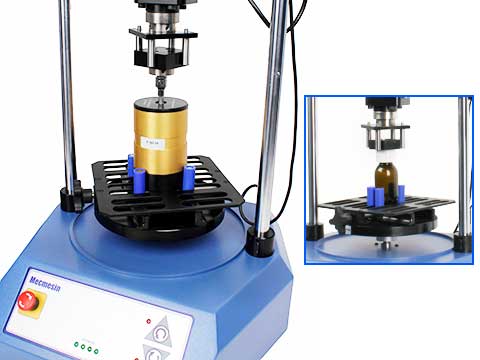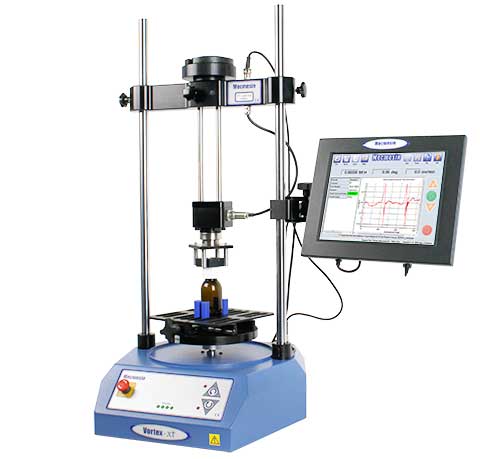Error message
Warning: file_get_contents(http://ipinfo.io/18.191.189.119/country): failed to open stream: HTTP request failed! HTTP/1.0 429 Too Many Requests in include_once() (line 656 of /home/closuretesting/public_html/sites/default/settings.php).ASTM D7860 − 14; Standard Test Methods for Measurement of Torque Retention for Child Resistant and Non-Child Resistant Packages with Continuous Thread Closures Using Automated Torque Testing Equipment
Measuring the torque retention of continuous thread Type I and Type II closures with matching finishes
These ASTM test methods evaluate the torque retention of continuous thread closures on containers, with matching finishes, for predetermined environmental conditions over time. These methods do cover CRCs Type I, style "A" push down and turn and Type II (lug-style) as well as non-CRCs and require automated torque measuring equipment.
This ASTM standards describes two test methods, each with variations for CRC or non-CRC samples:
- Test Method A: Static Evaluation—At predetermined time intervals, the removal torques of representative samples of a container/continuous thread closure system, previously stored at various environmental conditions, are measured.
- Test Method B: Dynamic Evaluation—Practice ASTM D4169 is used to develop a uniform system of evaluating the ability of primary packages, in the shipping units, to withstand the distribution environment. At the end of predetermined distribution cycles, the removal torques of representative samples of a container/continuous thread closure system are measured.
- Automated, transducer-based torque meter, with a programmable, fixed velocity rotational torque head and digital output.
- Torque Calibration Verification Device, magnetic type device that produces a repeatable breakaway torque within the expected torque range, used for verifying the measuring meter between calibration periods. A suitable device is the Mecmesin torque reference bottle.
- Select a single cap and container mold cavity number combination for testing.
- Verify dynamic calibration of the transducer based torque meter by measuring both the application and removal torque of a calibrated force meter with a torque calibration verification device five times before testing begins.
Test Method A—Static Evaluation Non–Child Resistant Closures:
- Select the minimum application torque as recommended by the closure manufacturer.
- For actuated (e.g. pneumatic) container clamping and manual style container clamping, place the container into the machine in such a manner that the axis of rotation of the closure is concentric with the centre of the measuring device.
- For positive actuated chuck style, start cycle and tighten the closure. For manual chuck style, affix the rotating measuring device to the closure and tighten the closure. Record both the predetermined applied torque and the rotation rate.
- Verify that the machine stopped applying torque at the pre-determined application value. (The application torque range is usually determined from the desired removal torque range.)
- Set-up machine for removal torque operation based on manufacturer's procedures.
- Determine the removal torque for each test specimen, with the specimen container again clamped appropriately and the closure gripped appropriately to the measuring device.
- Note the maximum torque to loosen the closure, the rotation speed and the dwell time.
Test Method A1—Static Evaluation Child Resistant Closures:
- Set up torque meter for application torque.
- Activate the CR locking mechanism with sufficient vertical force to prevent slipping of the lugs&emdash;enough force to engage the mechanism, usually a pre-determined load based on the design, applied by masses. Record the vertical downward force.
- Verify that the machine stopped applying torque at the pre-determined application value.
- Set-up machine for removal torque
- Note the maximum torque to loosen the closure, the rotation speed and the dwell time.
- Record the force required to activate the CR feature, maximum torque required to loosen the closure and the dwell time for each remaining specimen.
Test Method B—Dynamic Evaluation Non–Child Resistant Closures:
- Follow the procedures of ASTM Practice D4169 and D7386 for recommendations relevant to the number of test specimens, conditioning, and distribution cycles to be used to evaluate these test specimens. Calibrate the torque meter as above.
- Follow the above steps as in Test Method A for closure application.
- Measure and record the removal torque, as per Test Method A above, for one distribution cycle group immediately.
- Subject the remaining specimens to the selected distribution cycle and measure the removal torque. If information about long term storage is also required, then further specimens can be subjected to the required storage condition before removal torque measurements are made. Record the removal torque, the storage conditions, and interval before measurement.
Test Method B—Dynamic Evaluation Child Resistant Closures:
Follow the Test Method B, above, with references to Test Method A1 where appropriate.
Report to include the following:
- Method used.
- Closure manufacturer, complete material(s) construction of the closure and container.
- Thread finish.
- Description of specimen preparation and storage conditions.
- Application torque range and mean value.
- Removal torque range and mean value.
- Rotational rate torque measuring device during closure application and removal.
- Downward applied force for CR closures if applicable.
- Torque instruments used
- Calibration data for the Torque Testing Equipment; Serial Number or ID, measured results, and date of last calibration.
Further information should also be reported, refer to the ASTM document.
This overview is intended to provide a basic understanding of the test procedure and suitable equipment to meet the standard. Please refer to the latest official ASTM test method D2063 / D2063M - 10 (2012) for more detailed information.
Contact Mecmesin

Got a question about this product?
Our technical sales engineers can help find the right solution for your testing requirements and provide online equipment demos with your samples.

